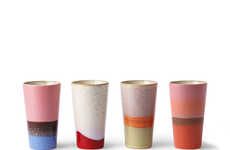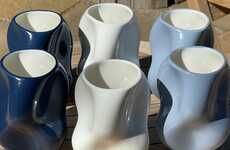
The Serax Lovatt Coffee Cups Replace a Handle With a Stump
Joey Haar — June 17, 2017 — Art & Design
References: poketo & betterlivingthroughdesign
In theory, it takes two qualities to turn a cup into a mug: it needs to be made out of ceramics and it needs to have a handle — but the Serax Lovatt coffee mugs prove that the latter is not necessarily a requirement. The mugs eschew the majority of the handle, keeping only what's truly essentially when grasping a coffee mug.
The Seerax Lovatt coffee mugs come in two sizes: a coffee or tea mug and an espresso mug. Both of these vessels are plain black ceramic with a white interior, and they both have the same design feature. Rather than a full handle, the mugs come with a small nub where the handle would normally protrude. When grasping the cups, this nub serves as support for one's thumb, acting in the same way as a handle while removing superfluous material.
The Seerax Lovatt coffee mugs come in two sizes: a coffee or tea mug and an espresso mug. Both of these vessels are plain black ceramic with a white interior, and they both have the same design feature. Rather than a full handle, the mugs come with a small nub where the handle would normally protrude. When grasping the cups, this nub serves as support for one's thumb, acting in the same way as a handle while removing superfluous material.
Trend Themes
1. Handle-less Mugs - The trend of creating mugs with a small nub rather than a full handle, creating a sleeker design and reducing the amount of material needed.
2. Minimalist Ceramics - The trend of creating ceramic objects with fewer unnecessary elements for a more streamlined and functional design.
3. Functional Simplicity - The trend of prioritizing functionality and simplicity in product design to create products with a greater emphasis on usability and ease of use.
Industry Implications
1. Ceramics - The ceramics industry can benefit from creating products with a greater emphasis on functional simplicity to appeal to consumers looking for minimalist designs with reduced environmental impact.
2. Kitchenware - The kitchenware industry could benefit from creating products with a more streamlined design by reducing unnecessary elements, reducing material costs, and creating a more attractive design for customers.
3. Eco-friendly Products - Companies producing eco-friendly products can create sustainable and minimalist designs using fewer materials and ensuring products are both functional and aesthetically pleasing to appeal to environmentally conscious consumers.
6.3
Score
Popularity
Activity
Freshness























